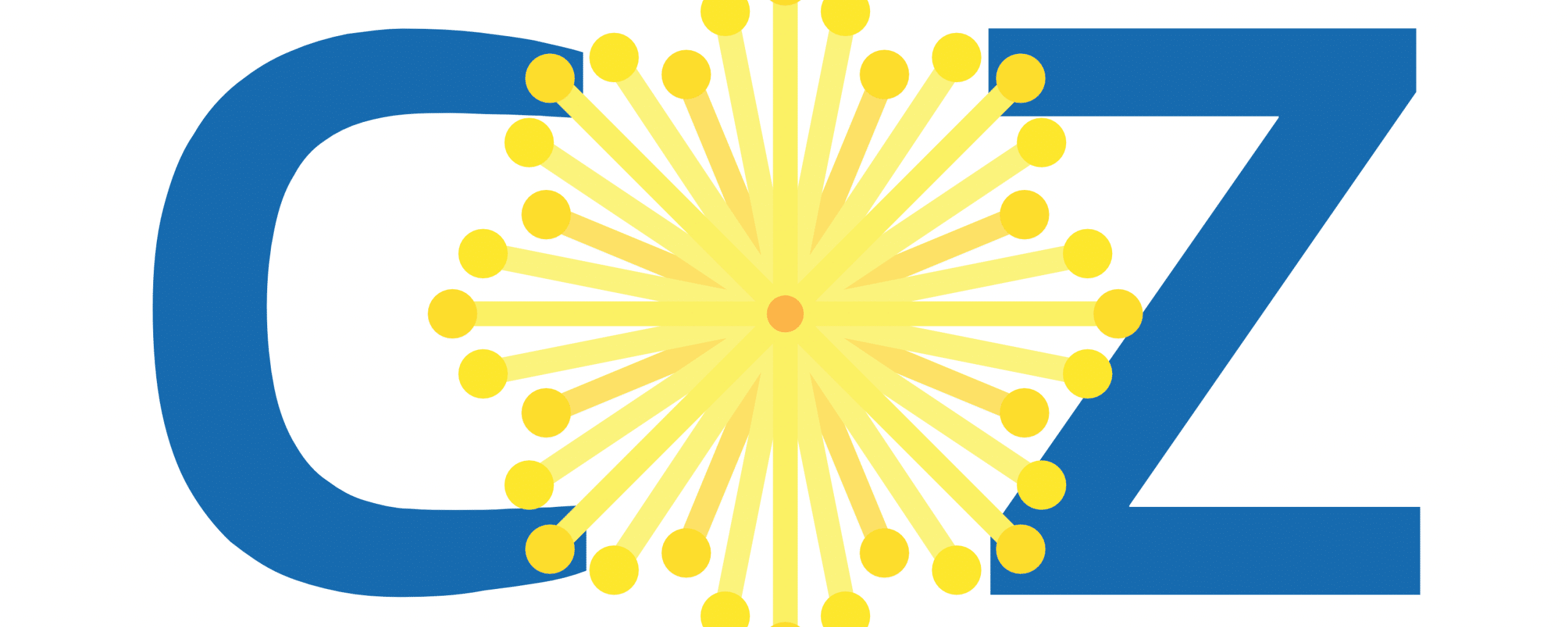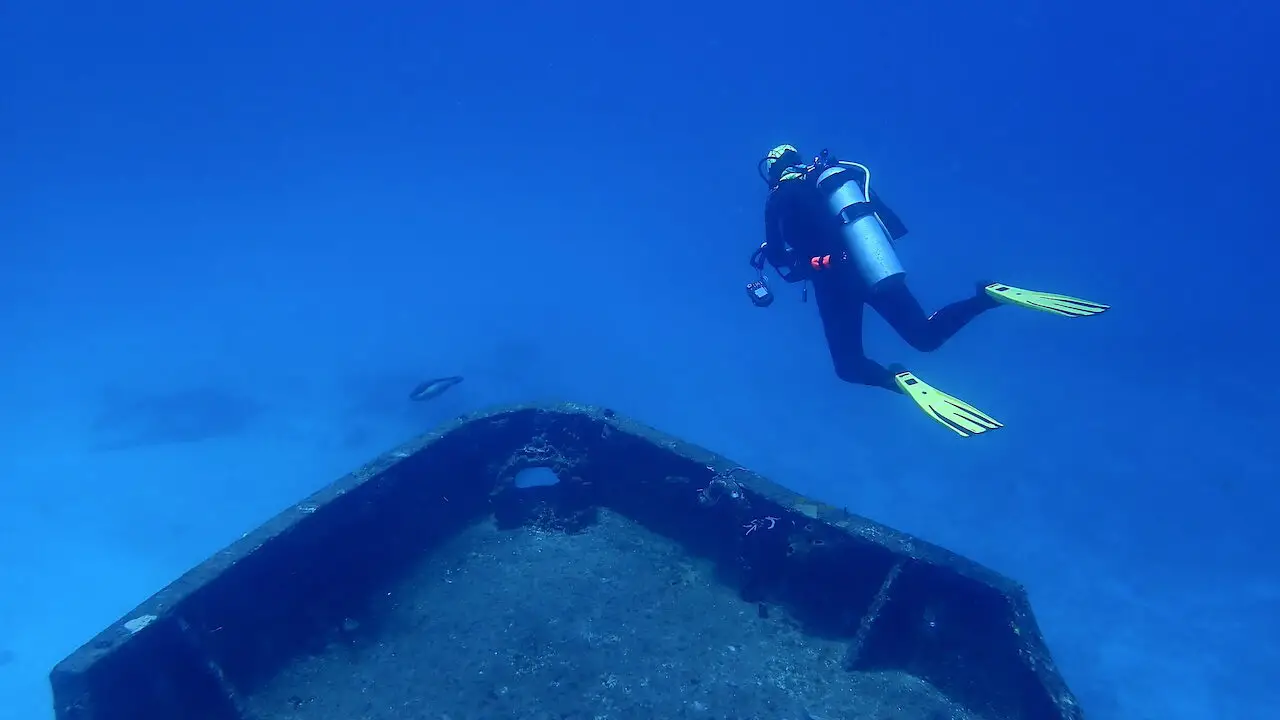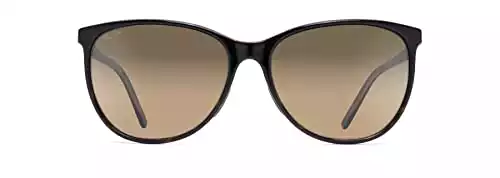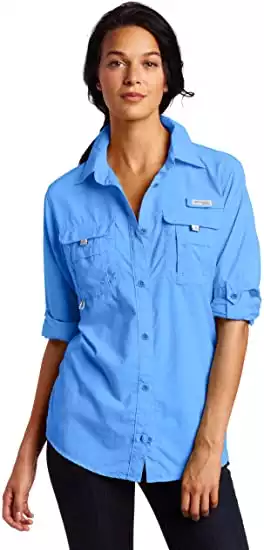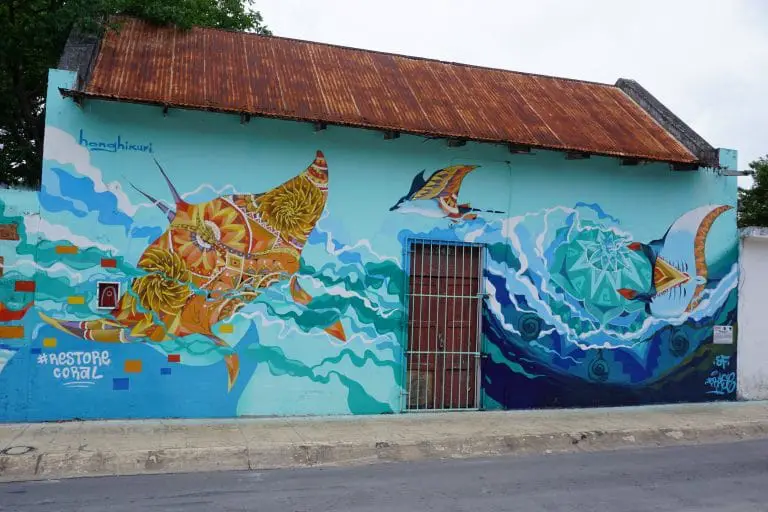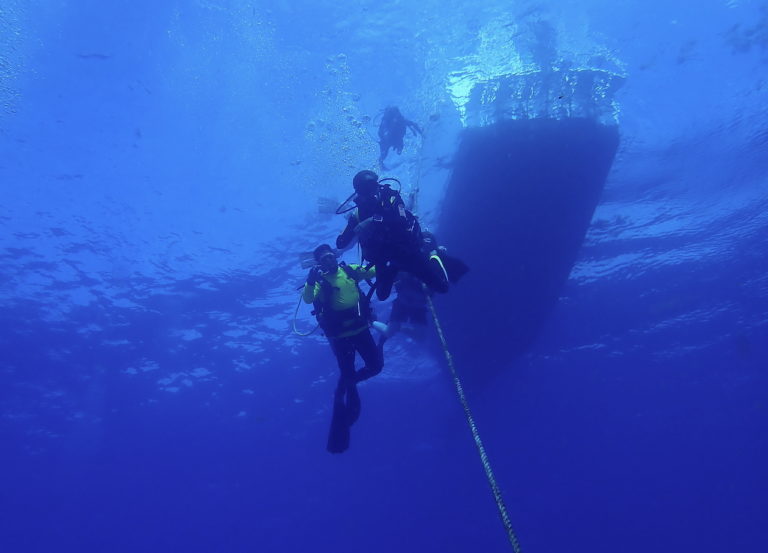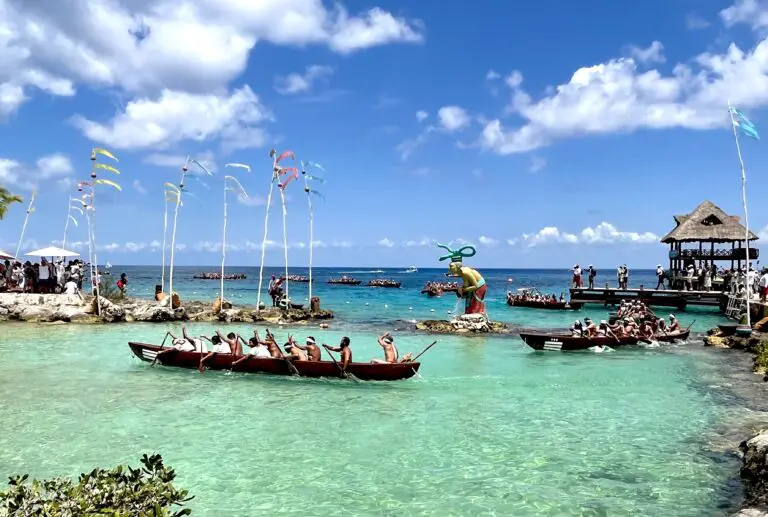Wreck Diving in Cozumel: Discover the C-53 Shipwreck
Wreck dives are not my true jam, but there’s just something so cool about diving into a sunken ship and exploring its history and imagining its stories. If you’re looking for a great shipwreck experience while scuba diving in Cozumel, the C-53 wreck dive site within Cozumel’s national marine park is your best bet, and just adds to all the reasons Cozumel is such a great place to dive year-round.
Divers who love wreck dives will want to schedule at least one dive at Cozumel’s main and best wreck-diving site, the C-53 shipwreck off the coast of Chankanaab Beach Park. The C-53 is a purpose-sunk wreck dive attraction, that was made safe for recreationally certified divers. The ship, a former US minesweeper that was sold to the Mexican Navy after WWII, sits upright on the ocean floor at about 75 feet deep, with the upper portions of the boat in about 40 feet deep water.
The C-53 wreck dive site in Cozumel requires advanced skills and experience to enter the vessel and see the interior.
Still, it’s not a dangerous dive, and dive groups of all skill levels can partake as long as you do so with a qualified dive guide.
Cozumel divers without a lot of experience or the appropriate certifications for this dive’s depth and semi-enclosed environment can simply opt to stay outside of the structure, where there is still plenty to explore and lots of Cozumel marine life to keep you company. (That’s what I do, and I have thousands of dives here – I find way more critters to photograph on the exterior!)
Let’s take a closer look at this unique wreck’s history, marine life encountered at the dive site, and some tips on safely diving the c-53 Felipe Xicotencatl in Cozumel.
The C-53 Wreck in Cozumel Has a Colorful History
Built in Tampa, FL as the U.S. mine-sweeper Scuffles, the ship was active during World War II. After the war, it was decommissioned in 1946.
A C-53 was discharged and sold to the Mexican Navy in 1962. It was converted into an Admiral Class Gunboat, and renamed ARM General Felipe Xicotencatl (C-53).
The C-53 was purchased to guard the Gulf of Mexico and the Caribbean Sea. She executed rescue missions and conducted surveillance of the area to prevent illegal weapons and drug trafficking.
In 1999, the Felipe Xicotencatl was retired again, now from the Mexican Navy, and in 2000 was purposefully sunk in the Cozumel national marine park, just in front of the Chankanaab Beach Park.
The C-53 is now Cozumel’s most famous and most visited wreck dive site.
Dive Briefing for the C-53 Wreck in Cozumel
Exploring The C-53 Sunken Ship in Cozumel
The C-53 is 184 feet long (54m), 33 feet wide (10m), and sits at about 80 feet deep (22m), making the upper areas of the ship rest at only about 50 feet deep (approximately 12m).
Points of Interest on the C-53 Wreck
Depending on conditions, the typical dive plan for the C-53 goes in this order:
- Stern of the Ship (deepest point, currently) – look for huge groupers and moray eels
- Interior Sections (If you’ve agreed to enter – confirm your dive plan with your buddy and your divemaster prior to gearing up and descending!)
- The C-53 ship’s main deck
- The Portholes (*popular photo op – see below)
- The Bow of the Ship – be sure to explore all the coral growth on the bow and look for tiny crabs, worms, and nudibranchs
- The Pilot House – the exterior of the pilot house is another great zone for macro photography, as it’s covered in growth that hosts tube worms, blennies, tunicates, and more
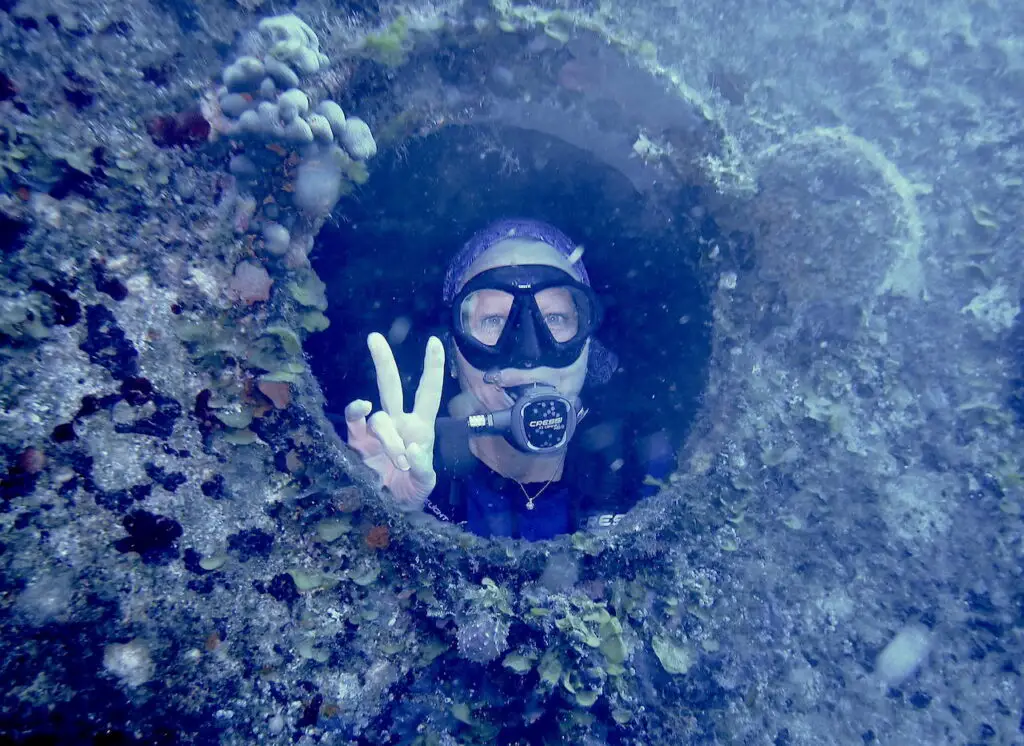
Basic Guidelines for Exploring the Wreck Safely
If you have your full open water certification and a good number of dives, you should know the hazards of diving in any wreck, especially those with enclosed spaces or overhead structure.
The C-53 is a purposefully sunken ship for use as a diving attraction. This means the boat was prepared for diver safety.
It has pretty broad areas for a single file of divers to enter and exit, and you are never in an entirely confined environment.
Nevertheless, it is a shipwreck in the wild ocean. And there are walls, ceilings, sharp edges, other divers, and lots of silt to kick up with your inexperienced fins (creating a hazard for you and other divers), so it still presents many of the typical dangers of diving in a shipwreck.
You should be appropriately certified for this type of dive, have some key basic diver safety gear with you, and given a thorough brief by your divemaster before you jump. But as a quick review, here are some fundamental safety notes:
Pay attention your divemaster’s briefing for that day.
Make sure you know if there are currents, whether you need to do a negative entry, and if they intend to ascend on the mooring line OR drift off the wreck with the current before the ascent.
These plans change depending on conditions, so always pay attention and listen to the briefing. Don’t be shy about asking clarifying questions if you don’t understand the plan or have never dived a wreck.
Don’t enter the boat, or penetrate the wreck, if you are not appropriately certified or experienced.
Plan ahead if you and your dive buddy will enter the wreck, and then stick to that decision (provided you have your divemaster’s approval)
If you do plan on entering a semi-enclosed section, be sure to have a dive light clipped to your BCD where you can easily turn it on and off without dropping it or losing your buoyancy or balance
Keep a close eye on your air gauge and your no-deco limits. The C-53 wreck dive is not super deep, but exploring the stern area at the beginning of the dive and then the interior sections of the ship could get you close to deco quickly, especially if it’s your second dive (it is typically a second dive in Cozumel).
The Cozumel Marine Park no longer allows divers to use knives, pointing/balance sticks, or diving gloves (unless you have a medical reason for gloves).
This rule primarily dissuades divers from touching and grabbing the marine environment. And yes, this goes for the C-53 Wreck dive, as well, so no hands.
Make sure your buoyancy is good, and don’t touch the boat while you’re down there. Some sharp edges, barnacles, and other natural growth could cut or scrape you.
There are also stingy little critters living in the coral growth on the ship, like bearded fireworms, fire coral, or other things that could sting or cause a rash.
If you are using the mooring line for your ascent, you can and should grab and use the rope to hold on and save air as you ascend slowly and do your safety stop.
Be mindful of other divers on the line, and wait your turn as your group goes up, off-gasses, and proceeds to the surface point and boat.
**You must leave plenty of air in your tank before this procedure, so you’re not rushing the divers above you or coming anywhere close to running out of air!

Cool Marine Life to Look For on the C-53 Wreck Dive in Cozumel:
Giant groupers hanging out under the stern of the ship
Huge green moray eels often find protected nooks to curl up and chill. Keep your eyes open, and don’t get startled.
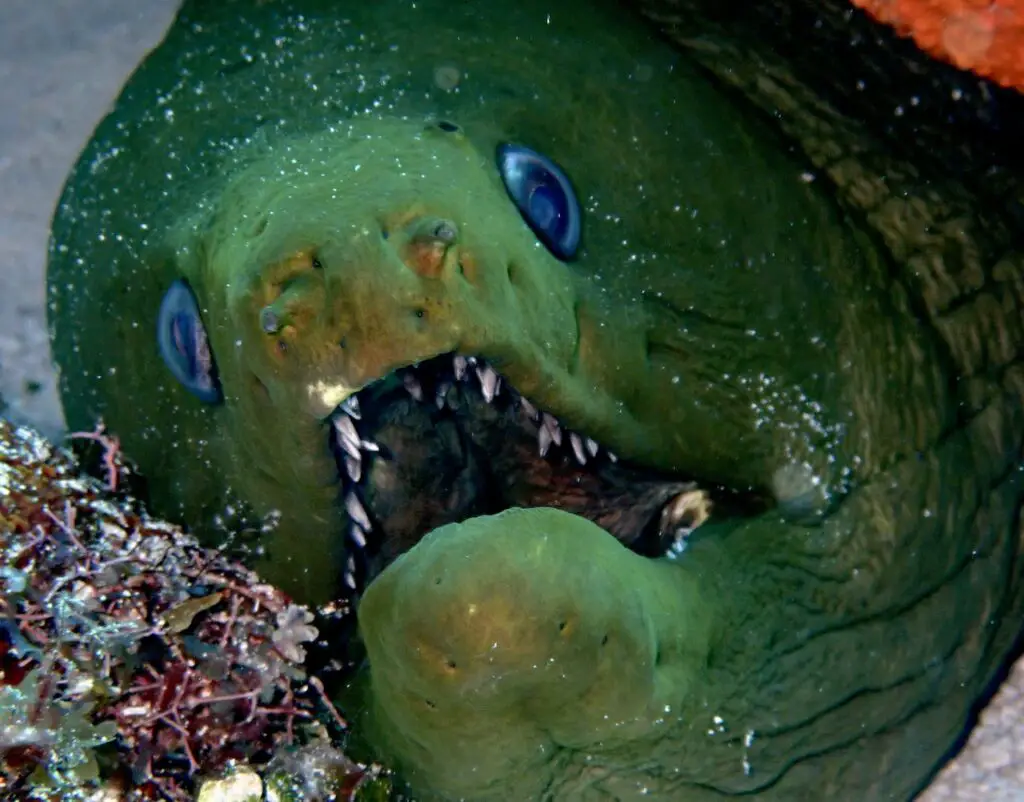
The ship’s bow is encrusted with growth – corals, sponges, barnacles, and more. This makes it an excellent place to search for macro sea life, including a good range of Cozumel’s juveniles, a constellation of various types of feathery tube worms, tiny but flamboyant nudibranchs and sea slugs, tunicates, hermit crabs, and more of our favorite Cozumel cleaner shrimps.
At the exterior of the bow on the ocean floor, there is an area of coral reef and rocky substrate. This area is usually home to spotted moray eels, lobster, arrow crabs, and more, along with corkscrew anemones that often house some Pederson cleaner shrimp.
Often on this dive you’ll be greeted by one of the strangest dive encounters – Cozumel’s Atlantis Submarine!
The Submarine ride in Cozumel (which is great for kids and families, btw) makes tour loops to nearby Chankanaab and passes the Felipe Xicotencatl.
Often if you’re diving the wreck, you’ll hear a loud, low rumbling sound and soon realize it’s the engine of this slow white submarine. Wave and say hello to the passengers – they get a kick out of it.

What to bring to dive Cozumel’s best wreck site:
- Certification and experience
- Good buoyancy
- Dive computer
- Dive light
- A healthy respect for diving underwater in/near underwater structures
- Curiosity
- Your log book – to check off another cool wreck site in Cozumel
- Underwater Camera (if you’re thinking of starting in
underwater photography , see our easy beginner’s setup at the end of this post, just below – it’s the exact camera and housing kit that was used for all the photos here and across the CozInfo website).

If you’ve forgotten any of these things, or find yourself in need of a backup, a spare battery, or other last minute piece of dive equipment, here’s a list of some great local stores that stock a lot of dive gear and accessories, and will likely have what you need.
Conclusion
Diving the C-53 wreck dive in Cozumel is a must for all experienced divers. The dive can be a moderately challenging but rewarding adventure, with interior sections to explore, diverse marine life that’s taken root, and lots of coral growth that hosts a variety of organisms.
As with all other dives in Cozumel, staying safe and enjoying the experience is the top priority.
Make sure to bring proper navigation tools, including a dive light for each diver, keep an eye out for any hazards, and if you enter the ship, keep your kicking to an absolute minimum.
Most importantly, don’t forget to take your time and take in the breathtaking beauty of the underwater world.
- Easy to use
- Easy to pack
- Easy on the wallet
- Durable, waterproof, dustproof
CozInfo’s Cozumel Packing Essentials:
|
Primary Rating:
3.5
|
Primary Rating:
3.5
|
Primary Rating:
3.5
|
Primary Rating:
3.5
|
|
$20.99
|
$279.00
|
$59.95
|
$24.99
|
